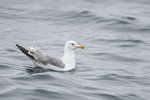

As I noted in my last column, before the year 2000 when the previously open county dump at Hawk’s Prairie finally closed, there were huge numbers of gulls wintering here. Those numbers have reduced substantially from the late 1990’s, but still, it is a rare day that you go out bird watching in our county and do not see gulls.
This is especially true in the fall and winter when gulls, both adults, and immatures, migrate to their Puget Sound winter-feeding grounds from summer breeding territories. Their arrival here matches up well with salmon spawning in the late fall, and gulls often congregate in the tidal areas of spawning streams. One of the best local areas to see these feeding gulls close-up is the tidal area Perry Creek, a small stream that feeds Mud Bay and crosses Highway 101 and Madrona Beach Road just west of Olympia.
This stream has coho and chum spawning in its lower reaches and the dead salmon wash out with the tide. For a number of weeks in late November and December, this is a feasting area for gulls, especially the larger species.
These larger gull species are really big birds, measuring 26” in length and with a wingspan of well over four feet. That’s larger than a Red-tailed Hawk. They are stocky and the different species look similar – that’s why finding a place to get a good look is important. The large gulls, incidentally, take four years to reach adulthood and immature gulls can have a wide variety of brownish color patterns.
The most common large species in our area is the Glaucous-winged Gull. As an adult, this is a white-headed gull with a very light gray back and wing tips. It has a large yellow bill with a prominent red spot and its legs are pinkish. In winter adults get a dark wash on their neck feathers. They likely will be the majority of large gulls you see.
However, the story of the large gull identification is anything but straightforward. That’s because all the large gull species in our area (Glaucous-winged, Herring, and Western) are closely related and hybridize readily. And, to complicate matters, this interbreeding has been going on for multiple generations and thus many (most?) of the large gulls are likely to be intergrades. The immature color patterns also often appear as intergrades.
Serious bird watchers can spend hours looking at a flock of large gulls. You may imagine that they’re looking for some rare species, but actually, they’re more likely looking for an adult gull that appears to be a purebred.
Identifications are a bit easier along the Washington Coast because there are breeding colonies of predominantly Western Gulls on the many offshore islands. Thus, we are likely to see large white-headed gulls with dark gray backs and black wing tips. These are Western Gulls, and they are occasionally be seen in southern Puget Sound.
My personal approach is to call them all “large gulls” and leave the challenge of sorting through intergrades and immatures to the experts.
There’s one more gull found in our area, and it has an interesting story. It’s the California Gull, a medium-sized white-headed with dark eyes, yellowish legs, and a yellow bill with a red spot. They have a medium gray back and black wing tips and may appear similar to the large gulls. But they are significantly smaller, and their beaks look much slimmer. These gulls mature in two years and identifying first- and second-year immatures can be confusing.
California Gulls are historically famous in Utah (maybe they should be called Utah Gulls). In the late 1840’s Mormons had settled in Utah Territory and their 1848 crops were threatened with destruction by swarms of crickets. Flocks of gulls arrived and feasted on the crickets, thus saving the settlers.
George Walter is environmental program manager at the Nisqually Indian Tribe’s natural resources department; he also has a 40+ year interest in bird watching. He may be reached at george@theJOLTnews.com
Photos for this column are provided by Liam Hutcheson, a 15-year-old Olympia area birder and avid photographer.
Comments
No comments on this item Please log in to comment by clicking here